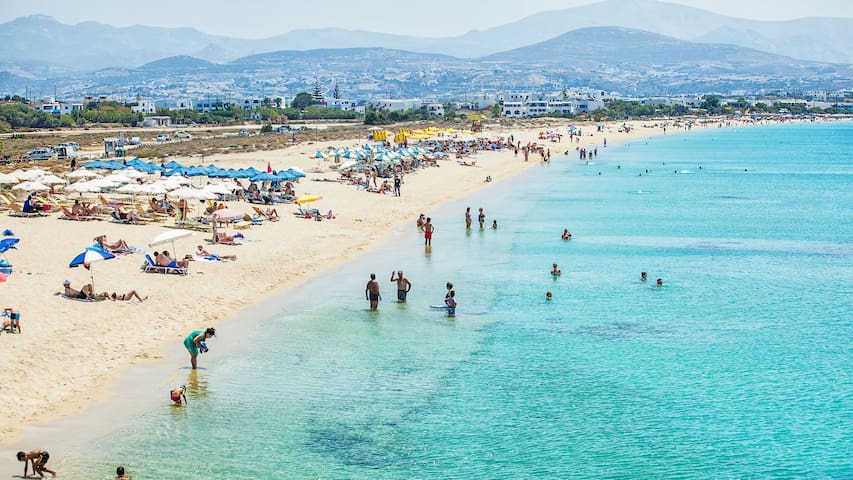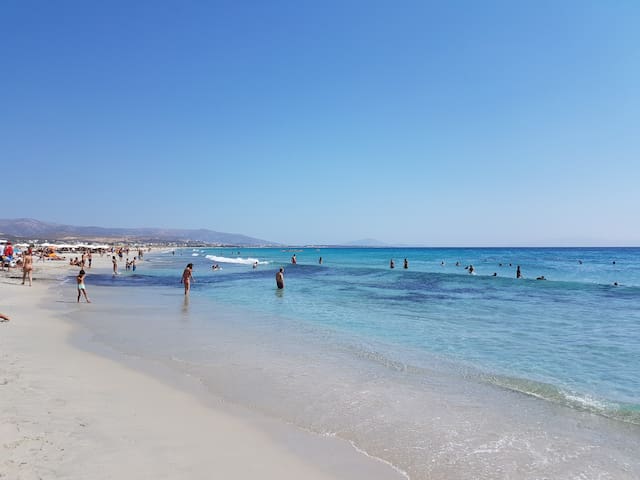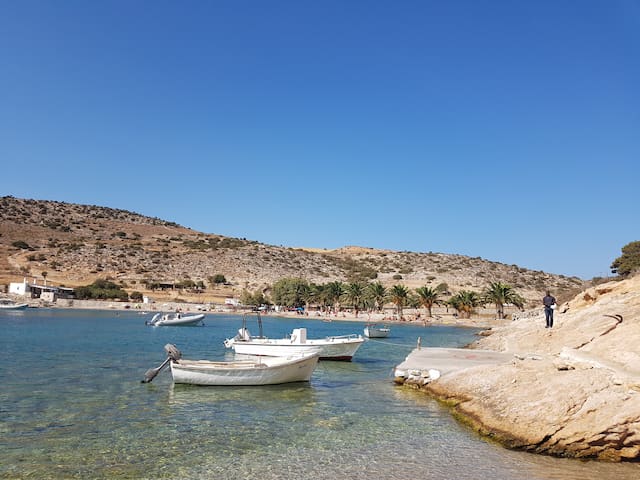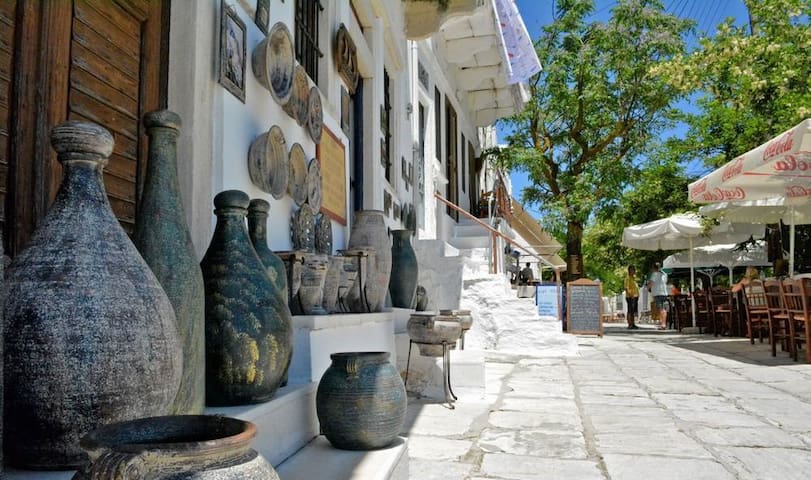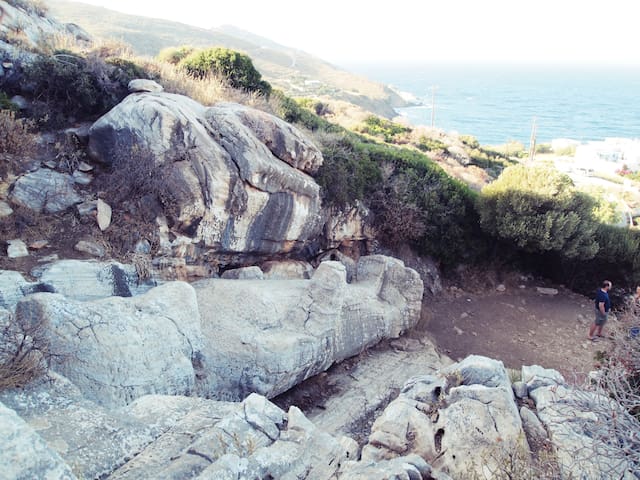Sightseeing
There are not many islands where their most famous archaeological site is the first thing you see when you arrive by ferry. This is the Portara, the doorway to the ancient Temple to Apollo which was built in 522 BC by the Tyrant Lygdamis and never finished, which sits on a small island in the harbor and is connected by a long causeway. They say if you stand in the doorway and make a wish you can feel the force as the energy of Apollo begins working to make your wish come true.
202 (рекомендации местных жителей)
Храм Аполлона - Портара
There are not many islands where their most famous archaeological site is the first thing you see when you arrive by ferry. This is the Portara, the doorway to the ancient Temple to Apollo which was built in 522 BC by the Tyrant Lygdamis and never finished, which sits on a small island in the harbor and is connected by a long causeway. They say if you stand in the doorway and make a wish you can feel the force as the energy of Apollo begins working to make your wish come true.
Awarded for its quality waters on both a Greek and international level, the beach of Agios Prokopios is truly magnificent. This long beach of light coloured thick sand has bright turquoise waters and its natural beauty is such that it attracts many visitors making it the 1st most popular beach of Naxos. Its unique colour and surroundings are what makes some people think of Agios Prokopios as a giant swimming pool.
Agios Prokopios is definitely the area to stay, eat and have fun from early till late. The beach is well organized, with umbrellas and sun-beds almost everywhere. During summer, the beach is packed with young people who enjoy its crystal clear waters and prefer its café-bars for their all day entertainment.
85 (рекомендации местных жителей)
Agios Prokopios
Awarded for its quality waters on both a Greek and international level, the beach of Agios Prokopios is truly magnificent. This long beach of light coloured thick sand has bright turquoise waters and its natural beauty is such that it attracts many visitors making it the 1st most popular beach of Naxos. Its unique colour and surroundings are what makes some people think of Agios Prokopios as a giant swimming pool.
Agios Prokopios is definitely the area to stay, eat and have fun from early till late. The beach is well organized, with umbrellas and sun-beds almost everywhere. During summer, the beach is packed with young people who enjoy its crystal clear waters and prefer its café-bars for their all day entertainment.
Mikri Vigla on the west coast is a masterpiece of nature, an artist’s paradise and an action photographer’s best choice since this is a famous wind and kite surfers' beach. It is a small headland that juts out into the sea and is found between the beaches of Parthena to the north, which is ideal for swimming and windsurfing and Sahara towards the south, a 4 Kilometre long beach of white sand and a veritable magnet for bathers. The beautiful whitish sandy beach of Mikri Vigla sets off the aquamarine blue hues of the sea beautifully.
57 (рекомендации местных жителей)
Mikri Vigla
Mikri Vigla on the west coast is a masterpiece of nature, an artist’s paradise and an action photographer’s best choice since this is a famous wind and kite surfers' beach. It is a small headland that juts out into the sea and is found between the beaches of Parthena to the north, which is ideal for swimming and windsurfing and Sahara towards the south, a 4 Kilometre long beach of white sand and a veritable magnet for bathers. The beautiful whitish sandy beach of Mikri Vigla sets off the aquamarine blue hues of the sea beautifully.
Panermos is a sandy beach found at the southeast of the island. Arguably one of its most attractive features is that it is one of the quietest beaches of Naxos. The golden sandy beach is due to its seclusion, ideal for those wishing to avoid the popular, crowded and noisy beaches one will come across during high season. With a hard look around you may also see the traces of the prehistoric acropolis which was situated on a low hill close to the beach and if you are so inclined, go take a closer look.
This is not an organized beach and due to its seclusion, offers no facilities, no umbrellas or sun-beds for rent, but there is a small beach cantina where you can buy drinks & snacks. A few palm trees are there for shade and the cove is a real delight with warm waters that are of course clean and crystal clear.
Insider Tip: At Panermos you can take the opportunity to jump on Captain Yiannis's boat and experience the two hour trip to inaccessible beaches and the Rhina sea cave. Don't forget to take your snorkelling equipment with you! ;)
19 (рекомендации местных жителей)
Panermos
Panermos is a sandy beach found at the southeast of the island. Arguably one of its most attractive features is that it is one of the quietest beaches of Naxos. The golden sandy beach is due to its seclusion, ideal for those wishing to avoid the popular, crowded and noisy beaches one will come across during high season. With a hard look around you may also see the traces of the prehistoric acropolis which was situated on a low hill close to the beach and if you are so inclined, go take a closer look.
This is not an organized beach and due to its seclusion, offers no facilities, no umbrellas or sun-beds for rent, but there is a small beach cantina where you can buy drinks & snacks. A few palm trees are there for shade and the cove is a real delight with warm waters that are of course clean and crystal clear.
Insider Tip: At Panermos you can take the opportunity to jump on Captain Yiannis's boat and experience the two hour trip to inaccessible beaches and the Rhina sea cave. Don't forget to take your snorkelling equipment with you! ;)
Apeiranthos village is by many considered the crown jewel of Naxos. Much of this belief is due to the fact that over the centuries it has managed to retain its unique authenticity which is apparent in every step you take, in every alley you walk and wherever you look. This is so not just because of the village and its uniqueness on the landscape of Naxos, but also for its nearly 1100 proud inhabitants who have kept their own distinct dialect where even a slightly trained ear reveals their true Cretan origin.
Amphitheatrically built at the slopes of Mount Fanari, it boasts magnificent views of the Naxian mountain ranges. As the locals say, while at Apeiranthos, there is no way of telling that you are, in fact, on an island. The feeling one gets is more that of a northern mainland Greece village than that of a Cycladic Island. This is partly due to its architecture and stone built houses but mainly due to its altitude, the centre of the village is located at approximately 600m from sea level.
This is no ordinary village, far from it; it is uniquely expressed in its awareness of history from several angles. At Apeiranthos you will find not one or two but 5 museums: the Apeiranthos Archaeological Museum, the Geological Museum, the Museum of Natural History, the Visual Arts Museum and the Folklore Museum, all worth visiting.
But its most impressive feature is its architecture. Stone built towers, old houses and churches, marble paved alleys, traditional small souvenir and local craftsmanship shops.
115 (рекомендации местных жителей)
Apeíranthos
897 Eparchiaki Odos Apiranthou-Ormou ApollonaApeiranthos village is by many considered the crown jewel of Naxos. Much of this belief is due to the fact that over the centuries it has managed to retain its unique authenticity which is apparent in every step you take, in every alley you walk and wherever you look. This is so not just because of the village and its uniqueness on the landscape of Naxos, but also for its nearly 1100 proud inhabitants who have kept their own distinct dialect where even a slightly trained ear reveals their true Cretan origin.
Amphitheatrically built at the slopes of Mount Fanari, it boasts magnificent views of the Naxian mountain ranges. As the locals say, while at Apeiranthos, there is no way of telling that you are, in fact, on an island. The feeling one gets is more that of a northern mainland Greece village than that of a Cycladic Island. This is partly due to its architecture and stone built houses but mainly due to its altitude, the centre of the village is located at approximately 600m from sea level.
This is no ordinary village, far from it; it is uniquely expressed in its awareness of history from several angles. At Apeiranthos you will find not one or two but 5 museums: the Apeiranthos Archaeological Museum, the Geological Museum, the Museum of Natural History, the Visual Arts Museum and the Folklore Museum, all worth visiting.
But its most impressive feature is its architecture. Stone built towers, old houses and churches, marble paved alleys, traditional small souvenir and local craftsmanship shops.
The Kouros of Apollonas, also called the Colossus of Dionysus, is a 10.7 metre tall unfinished statue of light grey Naxian marble with a weight of around 80 tonnes, which is located in an ancient quarry near Apollonas. The statue is a kouros dating from the Archaic period of Ancient Greece, around the turn of the seventh and sixth centuries BC.
In most cases, kouros statues depict naked young men with their arms at their sides. It is clear however that the Kouros of Apollonas was to be a depiction of an older man with a beard and that its right arm would have been stretched out in front of it. The archaic kouroi have usually been interpreted as depictions of Apollo. On account of its beard, the Kouros of Apollonas has instead been interpreted as the Greek god Dionysus.
The Kouros of Apollonas remains in an ancient marble quarry which is one of the oldest quarries in Greece. It lies not far from Apollonas on an unpaved road above the village.
73 (рекомендации местных жителей)
Аполлон Кур
The Kouros of Apollonas, also called the Colossus of Dionysus, is a 10.7 metre tall unfinished statue of light grey Naxian marble with a weight of around 80 tonnes, which is located in an ancient quarry near Apollonas. The statue is a kouros dating from the Archaic period of Ancient Greece, around the turn of the seventh and sixth centuries BC.
In most cases, kouros statues depict naked young men with their arms at their sides. It is clear however that the Kouros of Apollonas was to be a depiction of an older man with a beard and that its right arm would have been stretched out in front of it. The archaic kouroi have usually been interpreted as depictions of Apollo. On account of its beard, the Kouros of Apollonas has instead been interpreted as the Greek god Dionysus.
The Kouros of Apollonas remains in an ancient marble quarry which is one of the oldest quarries in Greece. It lies not far from Apollonas on an unpaved road above the village.
Established where Naxos’s ancient city once stood, Chora, the island’s capital and port, is located on the central west coast. Whitewashed Aegean-style houses, old stone-built mansions, narrow alleys and arches characterize the main town, spread around and within the medieval castle, or Kastro, built by Crusader Marco Sanudo in the 13th century.
Naxos’s main town is unique in that it offers visitors the opportunity to explore the busy modern streets and also roam through the castle’s medieval alleys for a trip back in time. This prospect makes Naxos’s main town one of the most popular destinations for visitors touring the Cyclades.
44 (рекомендации местных жителей)
Naxos
Established where Naxos’s ancient city once stood, Chora, the island’s capital and port, is located on the central west coast. Whitewashed Aegean-style houses, old stone-built mansions, narrow alleys and arches characterize the main town, spread around and within the medieval castle, or Kastro, built by Crusader Marco Sanudo in the 13th century.
Naxos’s main town is unique in that it offers visitors the opportunity to explore the busy modern streets and also roam through the castle’s medieval alleys for a trip back in time. This prospect makes Naxos’s main town one of the most popular destinations for visitors touring the Cyclades.

